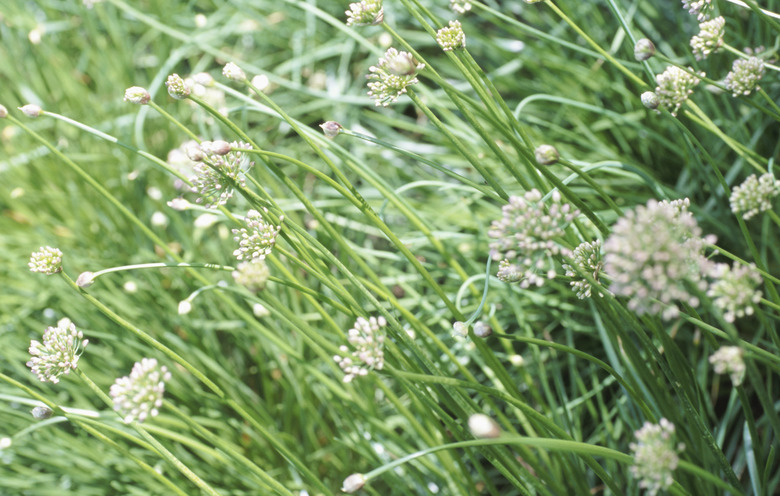Varieties Of Chives
Chives are perennial herbs rated for growing outdoors in U.S. Department of Agriculture hardiness zones 3 through 9 or 10. As a member of the onion family, chives are typically grown in edible gardens for use in culinary dishes. They also make attractive ornamental flowers in landscaping and will grow in a container environment with ease. Chives favor locations with full sun exposure and well-draining soil but will tolerate partial shade and poor soil conditions. There are several different varieties of chives available, with "common" chives being the most popular.
Common Chives
Step 1
Common chives (Allium schoenoprasum), with their onion-like flavor, can be eaten cooked or raw, and are popular in soups and salads. They have 10- to 12-inch spiked foliage that is hollow on the inside and topped with lavender-colored globed flowers in the early summer months. Common chives can be propagated by seeds or by dividing the plant every 2 to 3 years, which will help avoid overcrowding.
- Chives are perennial herbs rated for growing outdoors in U.S. Department of Agriculture hardiness zones 3 through 9 or 10.
- Common chives can be propagated by seeds or by dividing the plant every 2 to 3 years, which will help avoid overcrowding.
Garlic Chives
Step 1
Garlic chives (Allium tuberosum) have a taste of onion and garlic, and are commonly used in Asian cuisine such as stir fries and meat dishes. The plant can grow to 24 inches tall and has flat grass-like foliage. White star-shaped flowers appear on tall stalks in late summer to early fall. Garlic chives can spread quickly and self-seed easily. To control voluntary plants from taking over the garden, remove flower heads before they go to seed.
Giant Siberian Chives
Step 1
Giant Siberian chives (Allium ledebourianum) are said to have a richer taste than all other chive varieties, with a strong onion-garlic flavor. Giant Siberian chives are similar in habit and appearance to common chives, only taller. Their round, rosy-violet flower heads can grow as large as 2 inches in diameter in late summer. The sap from Giant Siberian chives foliage can be used as a deterrent for moths and other insect pests.
- Garlic chives (Allium tuberosum) have a taste of onion and garlic, and are commonly used in Asian cuisine such as stir fries and meat dishes.
- Giant Siberian chives (Allium ledebourianum) are said to have a richer taste than all other chive varieties, with a strong onion-garlic flavor.
Siberian Garlic Chives
Step 1
Like other chive varieties, Siberian garlic chives (Allium nutans) add an onion-garlic flavoring to any culinary dish. Commonly referred to as "blue chives," Siberian garlic chives have erect blue-green colored foliage and pink blossoms that emerge in midsummer. They can be grown in front of a sunny window indoors during the winter, and when planted outside make a great companion to carrots, beets and chamomile.
